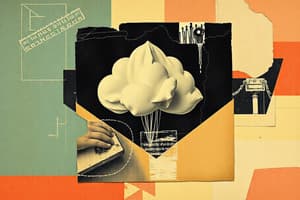Podcast
Questions and Answers
What types of messages can be exchanged using email?
What types of messages can be exchanged using email?
Text, audio, pictures, and video messages
E-mail clients do not read and send e-mail.
E-mail clients do not read and send e-mail.
False (B)
What is needed to configure e-mail?
What is needed to configure e-mail?
Name of mail server, username, and password
Which of the following email services do not require configuration?
Which of the following email services do not require configuration?
What does SMTP stand for, and what is its primary purpose?
What does SMTP stand for, and what is its primary purpose?
What are messages called in the context of internet news?
What are messages called in the context of internet news?
File Transfer Protocol (FTP) is used to copy files from a remote computer.
File Transfer Protocol (FTP) is used to copy files from a remote computer.
What is required to use FTP?
What is required to use FTP?
What is IRC?
What is IRC?
What is the purpose of channels in Internet Relay Chat (IRC)?
What is the purpose of channels in Internet Relay Chat (IRC)?
What is instant messaging (IM)?
What is instant messaging (IM)?
Instant messages are sent to all users.
Instant messages are sent to all users.
What do buddy lists contain?
What do buddy lists contain?
How do online services offer access?
How do online services offer access?
What are P2P services?
What are P2P services?
Peer-to-peer services have a centralized organization.
Peer-to-peer services have a centralized organization.
Flashcards
Using E-mail
Using E-mail
Exchanging messages between users electronically.
E-mail Messages
E-mail Messages
Text, audio, pictures, and video can be used in messages.
Email Clients
Email Clients
Programs that allow users to read and send emails.
Email Address
Email Address
Signup and view all the flashcards
Email actions
Email actions
Signup and view all the flashcards
SMTP
SMTP
Signup and view all the flashcards
Internet News
Internet News
Signup and view all the flashcards
Email Threads
Email Threads
Signup and view all the flashcards
File Transfer Protocol (FTP)
File Transfer Protocol (FTP)
Signup and view all the flashcards
Internet Relay Chat (IRC)
Internet Relay Chat (IRC)
Signup and view all the flashcards
Instant Messaging (IM)
Instant Messaging (IM)
Signup and view all the flashcards
Online Services
Online Services
Signup and view all the flashcards
Peer-to-peer (P2P)
Peer-to-peer (P2P)
Signup and view all the flashcards
Mail Transfer Agent (MTA)
Mail Transfer Agent (MTA)
Signup and view all the flashcards
Mail Delivery Agent (MDA)
Mail Delivery Agent (MDA)
Signup and view all the flashcards
Study Notes
Using E-mail
- E-mail is used for exchanging messages with other users.
- Messages sent via email reach their destination within seconds.
- Emails will remain in the recipient's mailbox until they are opened.
- E-mails can consist of text, audio, pictures, and video messages.
Configuring E-mail
- Email clients are used to read and send emails.
- Outlook and Eudora are examples of common e-mail clients.
- Configuring these clients typically require the name of the mail server.
- A username and password are required to use email clients.
- Hotmail and Yahoo are online email clients.
- Online clients do not require specific configuration.
How Email Travels
- SMTP stands for Simple Mail Transfer Protocol.
- SMTP handles the sending, receiving, and relaying/transmission of email messages.
Key Terms
- MTA (Mail Transfer Agents) are programs running on a mail server.
- MTA receive messages from mail user agents (MUAs) or other MTAs.
- MDA (Mail Delivery Agent) is a software component responsible for delivering email messages to a local recipient's mailbox.
- MDA is also called a local delivery agent (LDA).
E-mail addresses
- E-mail addresses provide a unique way of sending messages.
- Email addresses allow you to send and receive messages.
- An e-mail address is structured as [email protected].
E-mail actions
- The following actions are involved in the email process:
- Creating a new message
- Sending an attachment
- Replying to emails
- Opening attachments
- Forwarding an email
Major Features of the Internet:
- News sections work like a public board devoted to a topic, with potentially thousands of topics available.
- Messages within the news section are called threads.
- Users can create and comment on news threads.
- Using the news section requires a news reader program.
Other Internet Features: File Transfer Protocol (FTP)
- FTP is used for copying files from a remote computer.
- Using FTP requires an FTP client.
- Certain sites require a password to access.
Other Internet Features: Internet Relay Chat (IRC)
- Internet Relay Chat (IRC) provides a real-time communication system.
- IRC supports multi-users with communication through many channels, often called "rooms".
- Communication channels are commonly dedicated to a specific topic.
- All users are able to read the comments on the channel.
Other Internet Features: Instant Messaging (IM)
- Instant messaging (IM) allows for private, real-time communication.
- Messages sent using Instant Messaging are only sent to listed users.
- IM services use buddy lists to organize IM names.
Other Internet Services:
- Online services are companies that offer access by subscription.
- Common online services provided are banks, games, and research.
- These services support different kinds of online transactions.
Other Internet Services: Peer-to-Peer (P2P)
- P2P connects user computers together directly.
- Peer-to-peer services have no centralized organization.
- P2P users can communicate directly.
- Users can share files using peer-to-peer (P2P) services.
Studying That Suits You
Use AI to generate personalized quizzes and flashcards to suit your learning preferences.




